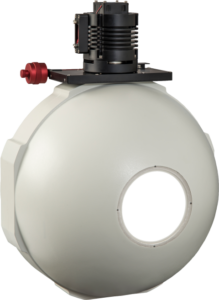An integrating sphere, or Ulbrict sphere, operates based on two principals:
– The diffraction or scattering of light inside the sphere and;
– Diffusion of this light in such a way that it strikes certain light-probing detectors.
The main function of an integrating sphere is to measure divergent light sources. As the name implies, it is spherical in shape and internally hollow. The sphere is internally coated with a highly reflective surface (also called a Lambertian surface).

integrating sphere
There is an entry opening, or port, for divergent light to enter, whereupon approximately 99% of this light is diffracted throughout the sphere. This scatters the light multiple ties until each individual beam reaches the same intensity. A photodetector housed inside the sphere receives this intensity if it is struck by one of the beams and measures the proportional power (the sum of all ambient light inside the sphere) of divergent light beam.
Requirements
An integrating sphere must have a uniform reflective internal surface with a diffuse reflectivity that is at or near 100%. There are different materials that must be used for the reflective surface. Each one responds to a different wavelength (visible, infrared, and ultraviolet). Each coating must maintain the absence of fluorescence, as absorption of short-wavelength light by fluorescent materials can negatively affect the detector’s measurements.
Baffles
Integrating spheres are sometimes constructed with baffles in their internal structure. Baffles are tubular structures that project the output of a uniformly radiating disk to the irradiance plane within the sphere. Baffles can help steer the diffused light to the internal detector. However, they are not spherical; instead, baffles are elliptical in shape. As a result, they will not uniformly illuminate the internal sphere surface. It is recommended that the number of baffles be kept to a minimum.
Applications
The integrating sphere has several uses in photonics, the most historic of which is measuring luminous flux. The ongoing study of luminous flux has paved the way for LED’s and LCD back-lights. Because of its properties as a uniform radiance source, the sphere can be used for imaging and non imaging illumination. The sphere’s geometry allows it to capture and measure the power of laser diode beams. By increasing the number of ports and adjusting sphere size, the sphere can take measurements from various incident angles. Measuring reflectance and transmittance of scattering materials remains the most prominent application of the sphere. Similar to spectroscopy, the sphere’s readings can aid in classification of various materials.
Integrating spheres also have their place in field radiometry. The spheres’ ability to collect all of a sample’s reflected radiation. Prior to the introduction of the sphere, it was barely impossible to carry out field radiometry without getting erroneous results.

